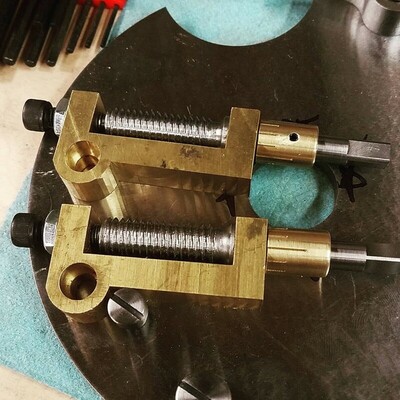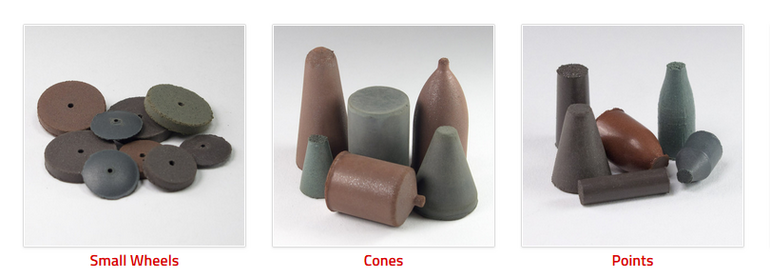When you bend them you have to polish them. When you polish them you should be using @cratexsandiego products or you are just wasting time. When you are wasting time you are loosing money. #gunsmith #gunsmithing #bolthandle #polish #polishing #cratex
Metal Polishing (Introduction)
Mechanical material removal process has numerous phases and each phase is characterized by the extent to which the material is removed. The first phase with the highest metal removal rate would be grinding . It usually comes after various cutting operations and it is a process of removing deformed or damaged surface material. The goal is to prepare the surface for finer finishing operations with minimal damage that can be removed in the shortest possible time.
Other material removal phases are deburring, sanding, lapping, smoothing, cleaning and finally – polishing. Same as other operations, polishing is used to remove the damage that was reduced but not completely removed by the preceding step.
The purpose of the polishing operation is to create a smooth and shiny surface, which is not necessarily mirror-like as many people seem to believe. If we were to point out the difference between different polishing processes, we would have to say that mirror-like polish is rather achieved by buffing, a polishing operation that uses loose abrasive applied to the work wheel. Polishing is used to enhance an object’s appearance, to create a visible difference in color and cleanliness and to create a reflective surface.
Abrasives used the most in the finishing phases are diamond, aluminum oxide and silicon carbide. Polishing process normally includes different progressively finer abrasive grit textures. If the material is unfinished, the process starts with a coarse abrasive (usually 60-80 grits), continues with various finer abrasives, so that each following abrasive has a finer grit than the preceding one until the desired look is achieved. A craftsman will go from coarse to 120 to 180, 220 or 240, 320, 400 and even above 1,000 depending on the kind of work that’s being done and the material that’s being polished.
The purpose of coarse grits is to remove highly visible imperfections on the metal surface, such as deep lines and scratches, pits and nicks. Progressively finer abrasives reduce these imperfections more and more, making them less visible until they are no longer visible with the naked eye. Achieving a mirror finish usually includes some sort of polishing or buffing compound, polishing tools and a high-speed polishing machine or tool.
This article will present different How-to metal polishing projects and various CRATEX finishing tools.
Click the icon to jump to the desired section
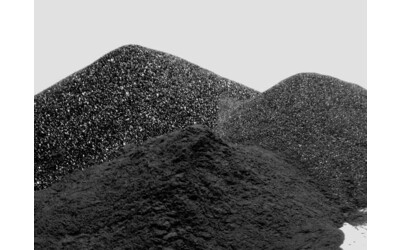
CHAPTER 1
Silicon Carbide (SiC) Abrasives
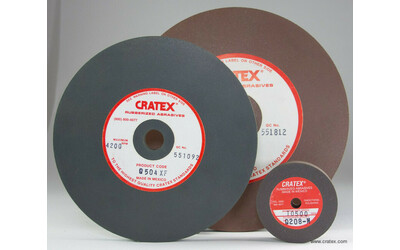
CHAPTER 2
CRATEX Silicon Carbide Polishing Wheels
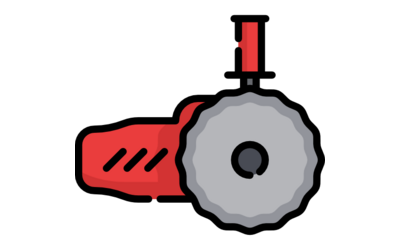
CHAPTER 3
How to Polish Aluminum

CHAPTER 4
How to Polish Silver

CHAPTER 5
How to Polish Stainless Steel
Silicon Carbide (SiC) Abrasives
CHAPTER 1
Silicon Carbide (SiC) or carborundum is a unique compound of silicon and carbon and is a sharp and hard synthetic mineral. It’s one of the minerals of intermediate hardness, since it is located between 9 and 9.5 on the Mohs scale (for reference, diamond is a 10, and corundum a 9). It is also a mineral that does occur naturally but is extremely rare – it is found in small quantities and in a limited number of places.
The mass production of the synthetic silicon carbide powder began in 1893, and the synthetic form has been used as an industrial abrasive ever since. It is commonly produced in electrical resistance furnaces by the Acheson process (the process is named after its inventor, E.G. Acheson). It develops as a solid block that gets crushed, classified, sometimes milled and sometimes chemically treated.
What is interesting about it, is that it is one of the few minerals that was created synthetically first, and only later discovered in nature. Namely, it was discovered in its natural form known as moissanite by the Nobel prize winning chemist, H. Moissan in 1905 in Diablo Canyon in Arizona, United States. Since it discovery, moissanite was not found in nature in larger quantities, and obtaining it for industrial use was difficult and rather costly. Therefore, the synthetic form remained the widely used form until this day. Since it is a transparent mineral that is almost as hard and brilliant as diamond, moissanite is often used as a gemstone instead.
Silicon carbide is a ceramic material has high-thermal conductivity, low thermal expansion and is therefore, extremely resistant to thermal shock. In addition, low density, high strength and hardness, high resistance to wear and superior chemical inertness (only inert to all alkalis and acids), make it a crucial material in industries, such as wear-resistant mechanical parts, aerospace, industrial furnaces and electronics. Although it has a high level of hardness, silicon carbide is more brittle than other abrasives - its grains break off easily enabling it to maintain sharp cutting action.
Due to its properties, it is used for grinding hard, durable materials, such as granite, chilled iron and marble, and for cutting materials such as copper, leather, fiber and rubber. It is also mixed with other materials to form abrasive compounds that are used in lapping and is used in combination with cloth backings in the production of abrasive disks, belts and sheets.
Along with the synthetic diamond, silicon carbide today is one of the most used abrasives in numerous industries and inevitable tool in most craftsman workshops. Thanks to its hardness, it is used in various machining processes such as grinding, honing, sandblasting and water-jet cutting.
What affects the wheel speed, its cutting power and the finish is the type of the bond agent that it’s used to hold the abrasive grains. Various types of bonds, such as vitrified, resinoid and rubber, will determine the exact wheel’s performance and application.
CRATEX Silicon Carbide Polishing Wheels
CHAPTER 2
When it comes specifically to CRATEX abrasives, they are made of pure silicon carbide grains that are bonded with special premium grade oil-resistant chemical rubber. Such an abrasive can be used on varied ferrous and non-ferrous alloys and many non-metallics, such as glass, plastic, porcelain and gemstones.
If we were to compare prices, rubber-bonded silicon carbide is more expensive than other abrasives. However, it possesses such a high level of purity that it surpasses other abrasives in performance with ease. For example, although aluminum oxide might be less expensive, you’ll end up using it more as it wears off quicker than the silicon carbide.
Besides, why would you settle for low-quality polishing wheels from hardware megastores? CRATEX delivers professional grade abrasives that are built to last and are designed to give you results that you were looking for and that you’ll be proud of. Whether you need small mounted polishing bits for your Dremel tool or large polishing wheels for bench grinders, we offer premium quality at prices that you can actually afford.
Precisely thanks to their durability, quality and performance, CRATEX wheels are used by modern lapidary , gunsmiths , knifemakers , jewelry makers , ortho lab technicians , deburring companies that specialize in aerospace and military and many other craftsmen. Typical general applications include light grinding, deburring, sanding, smoothing, cleaning and polishing. More specific applications include: smoothing and polishing molds, dies and other production tools, breaking edges, radiusing and polishing out high spots, cleaning and polishing, contact points, jacks and electrodes, polishing engine ports, shafts, turbine blades, smoothing, glass edges and jewelry finishing.
The grit texture you’ll use will depend on the workpiece material and the surface condition. CRATEX shapes and sizes are divided into four standard grit textures easily recognized by different colors.
- Green polishing wheels have the Coarse grit texture and the label C. Great for removing surface starches and material removal. Get higher polish using the wheels in colors below;
- Reddish polishing wheels have the Fine grit texture and the label F. Get fine shine in a second!
- Dark brown polishing wheels have the Medium grit texture and the label M. Use for pre-polish.
- Grey green polishing wheels have the Extra Fine grit texture and the label XF. Use for Ultra-shine finish.
1. Small Polishing Wheel
CRATEX small silicon carbide polishing wheels up to up to 1″ are perfect for delicate and precision work operations as they provide high-level of control. Tapered edge wheels are especially versatile and ideal for cleaning and polishing decorative and complex designs. Straight edge wheels provide absolute control of metal removal and ideal for work on sensitive scientific devices, light castings, aerospace components, dies and molds, instruments, electronic parts and jewelry.
CRATEX small rubber wheels can be mounted on conventional portable motor tools such as Dremel rotary hand tool and used fine and precision smoothing and polishing operations.
Recommended: In case you would like to try our products out, check out the Small Wheel Mini Kit No. 107. It’s a small kit of a total of 10 small wheels in medium, fine and extra fine grits, and 2 mandrels. And since we really want you to have the chance to fall in love with our products, the price is only $36.58 with shipping and handling included!
And in case you want to get yourself a more serious small wheel kit, we recommend . The kit contains a total of 44 wheels (both straight and tapered edge) and 2 wheel mandrels.
2. Large Polishing Wheel for Bench Grinder
Besides the small abrasive polishing wheels and bits, CRATEX also offers large rubberized silicon carbide wheels for bench grinders and mini bench grinders. Diameters range from 1 1/2" to 6", with 6-inch polishing wheel being the product sold the most often for bench grinder polishing operations.
These tools are perfect for various deburring, smoothing and polishing operations, such as cleaning before welding and soldering, smoothing glass edges, smoothing and polishing castings and punched or sheared pieces, polishing bearing surfaces and raceways, polishing welded seams after rough grinding, removing scratches, corrosion, rust and heat marks. To obtain expected results apply light work pressure and never exceed maximum speed. For best results use 30%-80% of maximum speed.
Recommended: To keep your bench grinder wheel in tip-top shape, remember to order your rubber dressing stick along with your polishing wheels. You can choose between rubber oblong and and square dressing sticks .
3. Silicon Carbide Polishing Points & Cones
Why use points and cones instead of wheels? Sometimes it is hard to polish small areas or curved surfaces using just polishing wheels. You need to use mounted points and cones around cylindrical and inner parts and tight areas.
Simply sharpen a point or a cone and mount it on your hand tool in the same manner as you would a mini rubber silicone polishing wheel and start making magic. They are designed for mechanical and manual operations. Same as for small wheels - you will need mandrels to attach points and cones to your tool as well.
Polishing rubber points are made in cylinder, bullet and tapered shapes and are used mostly for polishing molds, dies, light castings and patters, for cleaning contact points and solder spots and for relieving stress.
Polishing rubber cones are perfect for various difficult deburring, smoothing and polishing operations and are easily contoured and adjusted for specific uses with conventional CRATEX dressing sticks. Their typical usage includes polishing molds, dies, castings, turbine blades, shafts, stainless steel tanks, etc.
4. Polishing Sticks
Silicon carbide rubber-bonded CRATEX blocks and sticks are excellent hand tools for deburring, polishing and cleaning metal surfaces, smoothing away high spots, removing rust, heat marks and tarnish.
They are designed for either manual or mechanical operations, as they can be mounted in chucks, holding fixtures or cradles. Perfect for polishing shafts, rotating cylindrical parts, cleaning calibrations and reference points.
NOTE: Your feedback is extremely important to us. If you have any questions about the wheel sizes or you have doubt when choosing a grit, simply dial 800-800-4077, use our customer care live chat or send an email to sales@cratex.com.
How to Polish Aluminum
CHAPTER 3
First attempts to produce aluminum date back to 1760, and the first successful attempt happened 64 years later. Between 1845, when small pieces of aluminum were successfully produced and some of its physical properties were described, and Paris World’s Fair of 1878 aluminum went from a rare metal more expensive than gold to the symbol of future. Its price continued to drop rapidly and by the early 1890s aluminum had been widely used in jewelry, optical instruments and everyday items.
Today, aluminum is the non-ferrous metal used most widely, with just some of the applications in transportation industry (cars, trucks, railway cars, bicycles, trucks, aircrafts, spacecraft and many more), food and beverage industries, construction, consumer electronics and photographic equipment, musical instruments, and so on. Just look around your home – you’ll find tons of things that are made of aluminum or some aluminum alloy: tableware, kitchenware, cans, packaging, hardware, aluminum car parts, tools, watches, baseball bats… And you know what that means? Yes, that’s a whole lot of stuff that you can polish on regular bases.
Aluminum, like any other metal, oxidizes and oxidation cause tarnishing and eventually can cause rusting. Its shine can be recovered with polishing, but keep in mind that aluminum is a soft and light metal, so excessive and aggressive use of strong abrasive materials even when the item only needs dust wiping, will cause it to lose its luster and cause damage.
Depending on the type of aluminum (i.e. alloy) you’re planning to polish you can use different sets of tools. For example, you can use cloths and various aluminum pastes, jeweler’s rouge, rotary hand tool, bench grinder, sanding wheels, polishing wheels, sand paper, sanding or polishing blocks, etc.
How to Polish Aluminum Tableware (Hand method)
You’re probably wondering how to remove tarnish without damaging your aluminum platters, trays, cookware and other tableware items that have lost their shine over the years and are looking dull. Here you’ll need to be very careful with abrasive compounds, as aggressive pastes can easily inflict deep scratches.
Actually, what is great about polishing aluminum dishware is that you’ll need only a few things to do it and most of those things can already be found lying around your house.
To conduct this project, you’ll need:
- Water
- Dish soap
- Cream of tartar
- Soft cloths (old shirts, socks or underwear)
- Old toothbrush (or new one, just don’t use it for brushing your teeth again after this)
- Aluminum polish
Step #1: Wash
The piece that your going to polish needs to be completely clean, so use some dish soap, sponge or a rag and water and give your dishware a nice scrub. It should be washed, thoroughly rinsed and completely dry before your start with the polish.
Step #2: Rub
The cream of tartar should be mixed with water to create a light paste. The paste should be applied to the aluminum piece with a cloth in circular motions. The toothbrush will be included in this step as well in case your piece has indentations, etchings or similar imperfections, or in case you’ll need to get to those hard-to-reach areas.
Step #3: Rinse
Now rinse the piece and dry it once again with the drying cloth. Make sure you get the paste completely of the piece, so pay attention to tight spaces. In case the tableware piece is going to be in contact with food, Step 3 is your final step.
Step #4: Rub
So, only if you’re not going to use it as an actual dinning piece, take another cloth and polish it with aluminum compound by using circular motions. Aluminum compounds are toxic and should not be indigested.
Step #5: Wipe & Buff
Remove the compound with a clean cloth and use gentle buffing wheels for the ultimate shine. You can also do the buffing with a soft cloth and using small, circular motions.
Bling, bling, it’s done!
How to Polish Aluminum Wheels (Two Methods)
Perhaps aluminum can’t reach quite the shine that stainless can, but it sure can be made to shine like chrome. Since the metal responds really well to polishing, your aluminum rims can look brand new with just a little bit of effort. What is great is that you can maintain your wheels’ shine yourself, which won’t be tiresome in case you’re a car person. And there’s no unique way to do it. Every person found polishing tools, polishing liquids and compounds that they prefer, so pay attention to roughness of the tools and try a few things out before you find what works best for you.
Bear wheel polishing can be done quite quickly by different power and air tools, such as flex shaft, rotary hand piece or dual action buffer or just by your hand.
In case of the rotary tools, the wheels that you’ll mount will depend on the condition of your wheels. For example, in case you are dealing with rust or hard-core crud, you’ll probably need some stronger abrasive wheels or sanding discs. You can treat a curb rash with a flat file and you can also use various sandpapers to eliminate indentations. You’ll start somewhere from 180 or 220-grit (never go below 180 as you risk damaging the wheel) and progressively move to finer grits, such as 400, 600, 1000, 2000, 3000. In case you’re maintaining your wheels regularly and just need a little bit of work to get the shine back, you’ll go straight for the fine denim or cotton buffing wheels.
In case you don’t own any power tools, don’t worry as you can still do the polishing in your driveway or your car garage by using your ten fingers, some cloths and some abrasive compound, such as the good old Mag & Aluminum Polish or the Bling Master Inc. . Assuming that your rims are in pretty decent shape and you don’t need to use sandpapers, of course. The process might take a while, but the good news is that you won’t need to use much force. Optional but recommended: a fine tune and a couple of beers and you’re ready to polish away! And remember: the longer you rub with that fine cloth, the shinier the wheel will become.
Regardless of your tools, always start by washing your wheels to remove loose dirt and brake dust. Brake dust is a mixture of an adhesive and carbon fibers and rotor metal particles that becomes highly corrosive when influenced by the heat and friction generated by the wheels. A good way to protect your wheels and prevent corrosion is to frequently clean them.
Now that you understand what a menace brake dust can be, make sure that you rinse your wheels thoroughly and make sure you get into every little crevice. You can use non-acidic aluminum spray cleaner or in case you don’t have one of those, an oven cleaner will do an excellent job. Just spray it, leave it for about 20 minutes and scrub with a disc scrubber that is safe for Teflon surfaces.
After the polishing work is done, you can apply an aluminum brightening cleaner that will help you restore aluminum and will remove oxidation.
NOTE: Remember to wear safety glasses in case you are using a rotary polishing tool, wear a breathing mask as some polishing compounds are toxic, and make sure you grab a pair of gloves!
How to Polish Silver
CHAPTER 4
Every person who in his or her young life had to spend hours polishing silverware before a fancy Christmas, Easter or any other family dinner knows what suffering is. There's a long way from getting all the silverware out of a cabinet or down from a forgotten shelf to displaying it in all its glory on a nicely decorated kitchen table at times of a special occasion.
In between is an endless rub-rub-rub with that special silver polishing cloth. Silver spoons, knives and forks are annoying to polish, sure, but not as much as large, round silver objects. If you've ever used a silver polishing liquid, then you've also experienced a sneaky headache caused by all the fumes it produces.
Bet that not in a million years would you assume that there is a magical way to polish silver that doesn't include endless rub-rub-rub. As the mater a fact, it doesn't include any rubs at all. Those who first tried some of these easy silver polishing methods first felt disbelief, but then probably a combination of complete rage because of all those endless hours of silver-cleaning torture, and – a sense of complete amazement.
In the purpose of saving every child from rubbing silver household items ever again, we tested a dozen wacky DIY silver cleaning hacks and found the absolute silver-cleaning champion. But before we present our Top 5 Silver Cleaning Hacks and a few good ways to prevent your silver items from tarnishing, here are a few general things you should know about silver.
How does Silver Tarnish?
Silver tarnish is the discoloration or thin layer of corrosion that forms on items made of silver. It can be a yellowish tint, dark yellow or eventually – black.
Just to make things clear right away – fine silver consists of 99.9% pure silver and does not tarnish; sterling silver does. Sterling silver is an alloy of silver consisting of 92.5% of pure silver and 7.5% of other metals, such as copper. Copper makes the silver more durable and it allows the object to stay in shape.
However, these other metals, particularly copper, make sterling silver very sensitive to water and air. Because copper oxidizes easily, it is to blame for silver losing its charm with time and getting easily tarnished.
Oxidization isn't caused by the exposure to oxygen, however, but it occurs due to the presence of hydrogen sulfide or sulfur in the air. Unlike rust, tarnish affects only top layers and can only cause damage on silver-plated items that have a very thin layer of silver.
How Long Does It Take for Sterling Silver to Tarnish?
Anything made of silver can begin to tarnish in as little as 2-3 weeks. Silverware can take a bit longer to tarnish, anywhere between 3 weeks and one month. Jewelry tarnish can vary as it depends on the acidity level of the person wearing it and chemicals used in various beauty or cleaning products.
Top 5 Methods for Cleaning Silver
You can find a lot of silver-cleaning methods on the internet that involve items probably every household has lying around somewhere. However, although some methods are quite interesting and surprising, not all work so well. We decided to try a dozen of most popular methods out to see which ones provide satisfactory results and which are just a waste of time.
As a result, we came up with the Top 5 Silver Polishing Hacks that you can try and not get disappointed.
5th Place: Yummy Ketchup
Instructions: Squeeze a small amount of ketchup into a small container, grab a toothbrush, dip in ketchup and start rubbing.
What we liked:There is definitely a difference and there is always some ketchup in the fridge.
What we didn't like: It is too messy, smelly and it involves rubbing.
4th Place: Lemon & Salt (Without the Tequila)
Instructions: Put 3 tablespoons of salt into an appropriate-size container, add 1 lemon juice, pour hot water and stir well.
Place the silver item in the mixture and wait for about 5-10 minutes. Rub the item with a silver cleaning cloth until you are satisfied with the results.
What we liked:Not perfect, but decent.
What we didn't like: The rubbing. Unnecessary effort for results that are not perfect.
3rd Place: Laundry Detergent
Instructions: Fill an appropriate-size container with hot water and add one small cup of laundry detergent. Stir well, submerge the silver item and leave it in for 5-10 minutes. Rub and dry with soft cloth.
What we liked: Doesn't remove tough tarnish, but lifts the darkness, cleans the dirt and smells nice.
What we didn't like: Not effective against tough tarnish.
2nd Place: Good old Beer
Instructions: Pour beer into an appropriate-size container, add silver items and leave sit for 5-10 minutes. Rub and dry with a soft cloth.
What we liked: Not perfect but lifts the shade. No rubbing.
What we didn't like: You'll waste a lot of precious beer for larger silver items without getting perfect results. More suitable for cleaning jewelry pieces.
The Undisputed Champion: One-Minute-Wonder with Aluminum Foil & Baking Soda
Instructions:Grab an appropriate-size pan and cover the bottom and the sides with aluminum foil, shiny side up. Fill with boiling water, add baking soda (1 tbsp. per cup of water) and place the silver item inside. You can continue heating the pot over low heat or turn off the heat and let the item sit in the hot water.
In case you want to clean knives, forks and spoons, place them all on a piece of aluminum foil, wrap them up in it and pop them into the pot with boiling water and baking soda. Continue to boil the water for about 1-3 minutes, remove and rinse under cold water. Dry it and shine it with a cleaning cloth.
What we liked: Absolutely perfect results in a couple of minutes with no rubbing at all! You see how the foil becomes black from the tarnish, so it feels like a short, super-fun science experiment.
What we didn't like:Feeling like a fool for all the years of hard rubbing when we witnessed this method for the first time.
How to Keep Silver from Tarnishing?
It may seem like tarnishing is a natural process that cannot be stopped, but there are actually a few measures that you can take to prevent silver tarnishing or cause less tarnish to develop. Some of the things you could do are:
- Rub a small amount of conditioner on the surface of the silver item, which will polish it and protect it;
- Store silver items in acid-free tissue paper or unbleached cotton muslin inside a resealable plastic bag. Make sure the pieces are not touching each other as that could cause scratches;
- Keep a piece of chalk wrapped in cheesecloth in a drawer, a box or a bag where you keep your silverware or other silver items. The chalk will absorb the air moisture and prevent Sulphur from reaching the silver.
- There are also flannel bags treated with silver nitrate or other chemicals that you can use to store silver items. They come in different sizes appropriate for different items. For example, for silverware you can choose a bag that has a lot of different slots, so that the items don't touch and scratch each other, and for large silver items like bowls or trays you can get larger bags.
- You can also coat your non-food silver items with a thin layer of wax, as it will prevent air and water from reaching it and tarnishing it quickly. Just keep in mind that wax can make the silver look duller.
How to Polish Stainless Steel & Make it “Shine Bright Like a Diamond”
CHAPTER 5
Stainless steel is a universal term referring to a various steel type. Such as all other types of steel, stainless steel is made mainly from iron and carbon in a two-step operation. What makes stainless steel unique is the addition of chromium (Cr) and other alloying elements like nickel (Ni) to build a corrosion-resistant metal.
Steel corrodes due to the iron, the metal used to make steel. It appears out there in combination with other elements. When iron is artificially handled into a pure form to create steel, it causes an unstable state and will quickly recombine with oxygen.
When chromium has added to steel, it made chromium oxide, which performs as a guarding surface to reduce air and moisture from causing rust, as in the case of ordinary steel. Chromium has added in the ranging between 10.5 to 30%, relying on the application or environment in which the stainless steel will use.
Follow the lines below and learn in which all appropriate ways you can polish stainless-steel item.
How to Polish Stainless Steel
Most people think that stainless steel is unbreakable metal, resistant to corrosion and rust. Although more resistant than regular steel, stainless steel is not stain-proof. It only stains rarely than ordinary steel.
You have noticed that stainless-steel objects in your surroundings, especially those in extended contact with a heat source, starting to seem worn. Fortunately, there are several different techniques you can apply on how to polish the stainless steel and back it to its previous shape and glance.
Polishing Techniques
Relying on the type of stainless steel, you can polish with various tools and solutions. For example, you can operate with wheels, water, glass cleaner, vinegar, baking soda, olive oil, non-waxy and specialized cleaners.
Stainless Steel Polishing Using Rotary Tool
Rotary tools and polishing accessories include abrasive wheels, points, cones (mostly rubber-bonded abrasives), and brushes that can be used on stainless steel, aluminum, brass, silver, gold, and plastics.
For the wanted result use small wheel or large wheel made from silicone carbide, impregnated with premium grade chemical rubber.
Wheels, point, and cones are easy to use, no matter the purpose of your task.
- Choose the desired shape of abrasives. For a flat surface, it is recommended to use wheels, for a corner and hard to reach areas use cones and points.
- Another thing to consider is grit texture. Coarse grit is most aggressive. For polishing stainless steel best results is possible to achieve with fine or extra fine grit.
- After you have decide on abrasive shape and grit mount it on rotary tools using mandrel. Firm tight to Dremel or lathe and choose tool’s appropriate speed. The great thing about CRATEX polishing wheels and points is they won’t ruin material surface since they are rubber bonded.
- Now slowly run tool across the surface you want to polish. If you use bench lathe with large polishing whee,l hold workpiece against the wheel. In just a few steps and several seconds, you’ll polish stainless-steel and achieve a mirror finish.
IMPORTANT: Every time you use rotary tool use safety gear like a face mask, protection eyeglasses and gloves to protect yourself from injuries.
Despite their size, shape or grit texture CRATEX rubberized abrasives made of silicone carbide (SiC) are perfect to:
- Clean and polish metal accessories and fittings. You can optionally use oil or water as a lubricant;
- Great for cleaning and fine polishing hard to reach areas,
- Remove paint from the metal surface,
- Polish aluminum and silverware,
- Wheels are adequately for polishing away fatigue lines, scratches, and other surface defects.
Perfect for work on stainless-steel items, dies, molds, instruments, control mechanisms, electronic parts, jewelry polishing, aerospace components, light castings, models, and super sensitive scientific devices. Applied by professional jewelers, gunsmiths, dental technician, knifemakers, lapidaries, bladesmiths, silversmiths, etc.
Olive Oil Usage
Using olive oil for steel polishing is a less aggressive method that can remove only light rusty spots.
Open the olive oil bottle and spill some oil on the cloth or dip a cloth in oil for several seconds.
Before you begin to polish stainless steel, cover the whole surface of the workpiece with olive oil. Same stands for grooves and hard to reach corners.
The method is pretty simple, indeed. All you need to do is to brush workpiece applying substantial pressure with a cloth until you notice a light shine over the surface.
Use clean cloth or paper towel to eliminate excess liquid. If the oil stays on the metal, it can dull it instead of buff it. Apply a clean, soft cloth until thoroughly dry.
Since you have finished brushing down the material, barely touch it. If it’s still oily, carry on sweeping. Apply the clean cloth to take off the fingerprints.
Vinegar Buff
Pick the right vinegar since particular kinds of vinegar can run better than others. White and cider vinegar runs equivalently on stainless steel, although cider vinegar makes a more pleasant scent. Cleaning vinegar is excellent for tough dirt spot due to its sharp acidity. If your object is highly oxidized, choose cleaning vinegar.
Look at the direction of the grain. Such as wood, stainless steel has a grain that will go vertically or horizontally. Brushing the item down in the course of the grain will aid you to see the small grooves where dirt can get collected.
Load the vinegar in a spray bottle. Then, spray the vinegar across the stainless steel until the object has lightly coated in it. If you don’t have a spray bottle, you can dampen a cloth in vinegar and equally wipe the item.
For light buffing, water down vinegar (half cup of vinegar for each quarter of hot water).
Applying a smooth cloth or paper towel, rub the vinegar off in the grain course. It will remove rubbish from the object and restore its sheen. Don’t forget to brush in the grain direction. You should avoid vinegar remains trapped in the grooves and make your item to lose color over time.
Non-Waxy Style
Purchase a non-waxy steel polish. Waxy polishes leave behind a thin coating, which can progressively dull your item during the time, that is why you need a non-waxy polish.
Pick an oil-based cleaner or water-based cleaner. Water-based cleaners won’t remove stains or fingerprints from an object. For the best buff, take an oil-based cleaner. Water-based cleaners are better for the environment, typically less flammable and less harmful. Weigh which one is more suitable for your task.
Use a well-ventilated area to polish stainless steel. Specialized cleaners can produce vapors that are dangerous to breathe in small spaces. Rub your item near a window or outside to avoid dizziness. Open windows and doors before you start cleaning.
Use rubber gloves when you spray to avoid contact with your hands. Rub the item down in the course of the grain. Use a dry cloth to brush down your object. After you have finished brushing down the item, it is ready for use.
Water Method
On some occasions, all you need is some hot water to clean the dullness out of stainless-steel pieces. Use a cloth that’s been slightly wet with warm water and wipe off the material.
Don’t wait to water beads dry, clean the metal with a clean, dry cloth. A chamois cloth or shammy leather will fit suitably for this task. It’ll absorb the water straight away and polishing the stainless-steel surface at the same time.
Glass Cleaner Technique
For stainless steel materials that haven't used in the kitchen or for food purposes, wiping them with glass cleaner is an efficient way of restoring and polishing to a mirror finish.
This technique simplifies the work of wiping old water stains and built-up dirt that has collected on your stainless steel. Still, as soon as the cleaning has done, it’s necessary to rinse the material with hot water and dry it entirely to eliminate any chemicals left behind. Drying it expeditiously is a must to prevent the creation of new water stains.
Baking Soda Technique
Like vinegar, baking soda is also a useful kitchen article that has high cleaning potential. In a clean dish, mix baking soda with hot water until you create a paste. Take a clean cloth to scrub the paste on the entirely stainless-steel material and then rinse it with warm water and dry it with a clean towel.
Specialized Cleaners Usage
In your local store you will notice certain products only for cleaning and polishing stainless steel. These are suitable if the metal you need to clean is highly tarnished or scratched.
It’s crucial to know that not all of these products are safe for use on materials that come into touch with food. Those that provide food safe label. Besides that, you should only use these products in an adequately-ventilated area, and it's necessary to wear a mask. Before using the cleaner on the entire item, try applying it in an inconspicuous place to ensure it doesn’t cause any discoloration of the stainless steel.




